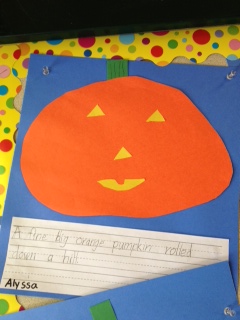October = Pumpkins. Yippee!!
Pumpkins are always a high interest topic so many (all?) teachers use them to the fullest in language acquisition, reading, writing, math, you name it. This year, we are focusing more than ever on writing "super sentences." The art of building a super sentence lies with the use of adjectives, fantastic verbs, and interesting prepositional phrases.
I selected The Runaway Pumpkin by Kevin Lewis because it was on my shelf, but also because the author uses language that goes just enough beyond a child's knowledge base so that it enriches vocabulary in a way that's memorable and fun, but it's not so far advanced as to cause their eyes to glaze over. When asked to describe pumpkins, first graders will typically say "orange," "big/small," "cool." Their vocabulary isn't exactly mesmerizing.
By using this story as a base for vocabulary development, I can get students to say and use words like big, orange, round, fat, fine, thumpin', bumpin', and runaway to describe their pumpkins! In addition, the pumpkin in the story zooms, bounces, rolls, and speeds down a hill, causing all kinds of destruction (we all love witnessing destruction, right!?) to the characters' parents' chicken coop and pig sty as it rolls down the hill.
Using an adjective before a noun doesn't come naturally to six year olds, neither does using a capital, spaces and ending punctuation, but that's another story. Once the scaffolding was done and we'd practiced building sentences orally, it was still a challenge for many to construct a truly "super" sentence, but it was well worth the effort.
Here are some of the results:
 |
| This student struggled and had to start over, but he reveled in the applause that came when he shared out. |
 |
| This student really loves the word "zoomed!" I will work with her more when constructing a super sentence. |
 |
| This student really got the adjective aspect! |
To begin, I read the story for enjoyment. They really got into it! Then when I read it again, I told them to listen for words that tell what pumpkins are like. "Pumpkin" will be our noun, so these are words that tell about pumpkins, they were told. We made a list on the board. Then we came up with four actions that happened as the runaway pumpkin rolled down the hill.
Once we'd done some oral work with the words (the most important part in my opinion), I gave them a graphic organizer with a pumpkin in the middle and four vines with big leaves coming off its stem. In the middle of the pumpkin they were to write the noun (pumpkin) and on the leaves, adjectives from the board. This is where I should have concluded until the next session, but nooooo. Nothing went wrong, I just sensed the energy level waning. But no worries, it all worked out.
When it was time to transition from the graphic organizer to the sentence writing, most could do it! I was so happy. There were also many who struggled, but with a little help, were able to be successful.
Their reward for hanging in there, for doing hard things and not giving up, was to make a pumpkin with scissors, paper, and glue. They loved it!
The next time I do this lesson (next year) I will make some changes. I'd break it up into smaller lessons, mostly, and I'd do more with the oral practice before moving into writing anything.
I don't have the graphic organizer right now, so I'll scan and add it to the post next week. You can easily make one, though, by drawing a pumpkin, vines, and leaves big enough to write a word inside.

No comments:
Post a Comment